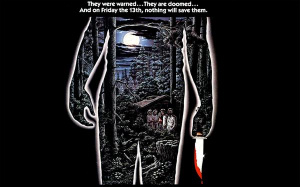
Director: Sean S. Cunningham
Writer: Victor Miller
Starring: Betsy Palmer, Adrienne King, Jeannine Taylor, Robbi Morgan, Kevin Bacon, Harry Crosby
Rating: R (USA), 18 (UK), R (Australia)
It is strange to think that before the hockey mask, before the merchandise, before the sequels and the imitators and the pop culture superstar that is Jason Voorhees, it all started with one film. In fact, before that there was just an idea – let’s rip-off Halloween. There was no desire to make art, or to challenge the audience in any way. Friday the 13th was created purely from a business standpoint, by a fledging producer who had enjoy one success story, only for it to be followed by a string of disappointing flops. The aim wasn’t to create an iconic movie monster or usher in a genre of low budget slashers, all he wanted to do was avoid bankruptcy and earn a small profit. He had seen one idea after another be squandered or abandoned and the horrible truth was slowly creeping upon him – perhaps the film industry wasn’t for him. But then Halloween was released and became a surprise success. This convinced him that if he could conceive a premise for a cheap horror film then he would be able to sell it and this would allow him to develop a television idea he had been considering. With this in mind, Friday the 13th was born.
Sean S. Cunningham was born on December 31, 1941, in New York City and had graduated from Franklin & Marshall College in Lancaster, Pennsylvania before attending studying a Drama and Film Master’s degree at Stanford University. Despite considering a life in medicine, he had strong aspirations of becoming a filmmaker and landed a job as a stage manager for a theatre company. Eventually progressing to industrial films and television commercials, Cunningham’s first job as a director was the self-financed sex-education feature The Art of Marriage, which he produced on a budget of $3,500. Earning a modest profit for his efforts, he hired out an office space in New York and raised $50,000 from family and friends for another adult film, a pseudo-documentary entitled Together, which he developed alongside his production partner Roger Murphy, who had previously worked as a cinematographer on Monterey Pop, a 1968 film that covered the Monterey International Pop Festival in California. Shooting in his home town of Westport, Connecticut, Together starred future adult actress Marilyn Chambers (who would later become familiar to horror fans from her performance in David Cronenberg’s 1977 Canadian shocker Rabid) and was intended to follow a similar style to his last feature.
When the editing process proved to be a challenge, Cunningham hired another wannabe filmmaker, Wes Craven. Having earned degrees in English and Psychology at Wheaton College in Illinois and Philosophy and Writing from Johns Hopkins University in Baltimore, Craven had quit the profession to focus on breaking into the movie industry, a decision which had cost him his marriage. Having gained experience working in post-production, Craven had come to the attention of Cunningham, who was desperate to finish his film. Once completed, he took his product to Boston to meet with the owners of Esquire Theatres of America, a New England-based company that had recently expanded to film distribution, having acquired the rights to Mario Bava’s latest flick Reazione a catena, which they had renamed Twitch of the Death Nerve. The company was run by Stephen Minasian, Philip Scuderi and Robert Barsamian, who had created a division of Esquire, Hallmark Releasing Corporation, to focus on feature films. Suitably impressed with Together, they paid $10,000 for the distribution rights and offered Cunningham a further $50,000 to develop a low budget horror.
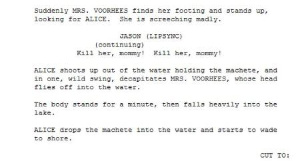
Craven was offered the chance to both write and direct and began loosely adapting Ingmar Berman’s 1960 Swedish classic Jungfrukällan (The Virgin Springs), which told of a trio of herders who rape and murder a girl, before unknowingly taking shelter in her family’s home, only to be brutally murdered by her parents upon discovering the truth. When Cunningham submitted Craven’s screenplay, Sex Crime of the Century, to Hallmark, Minasian and Scuderi enthusiastically allocated a further $40,000 to the production. Cunningham began to assemble a crew, which included a twenty-year old by the same of Stephen Miner, an art school graduate and ski bum who had moved back from California after travelling with a group of friends in a rock band and had decided to make a start in the industry. Principal photography commenced in Connecticut and New York between 2 October and 6 November 1971, eventually being released on 30 August 1972 under the alternative title, The Last House on the Left. The film proved to be a major success but both cast and crew would be heavily criticised for their involvement in such smut. David Hess, who had played the key antagonist, Krug, would become stereotyped as a sadistic villain, while both Cunningham and Craven would be considered one step up from pornographers.
Desperate to shake off the stigma, Cunningham and Miner attempted to explore different genres whilst Craven and his production partner, Peter Locke, went their own direction. Scuderi contacted Cunningham with the proposition of copying the success of the recent hit Bad News Bears by producing a family sports comedy and soon he had met the acquaintance of writer Victor Miller. The two would collaborate on Here Come the Tigers, as well as the similar Manny’s Orphans, which United Artists had expressed interest in transforming into a pilot for a TV series. But in late 1978, an independent thriller that had been made with a mere $320,000 was released and would take the industry by storm. Halloween had been the brainchild of Irwin Yablans, a producer who shared many of the same qualities as Cunningham. Directed and co-written by twenty-nine year old John Carpenter, a USC graduate whose previous effort, Assault on Precinct 13, had won him minor acclaim, Halloween boasted many elements that had appealed to audiences – startling cinematography, a creepy score and, more importantly, a menacing villain. Cunningham immediately contacted Miller and suggested that he watch the film to dissect its formula and find the winning ingredients.
Although initially hesitant about returning to the horror genre, Cunningham knew that if he could develop something similar then he would have a product that he could sell. The two began discussing the story that Miller could adapt into a script and found that there were several aspects of Halloween that could be reproduced – the strong heroine, the sexually promiscuous teenage victims and some prior evil that has cast a curse upon the town. Miller knew that the key element had to be an isolated setting where the kids would be out of reach of adult help and suggested a summer camp. He began developing his screenplay, entitled Long Night at Camp Blood, which would take two rewrites before Cunningham was satisfied enough to take to the investors. Knowing that Halloween’s success was partially down to its instantly gripping name, he eventually settled on Friday the 13th and published a full page ad in Variety that declared, “ The Most Terrifying Film Ever Made! Available December 1979.” His old friends at Esquire immediately contacted him expressing interest in his new project and offered to distribute it under their banner Georgetown Productions. Although they were impressed with the concept, they had reservations regarding Miller’s screenplay and commissioned Ron Kurz, a struggling author from New Hampshire, to work as an uncredited script doctor.
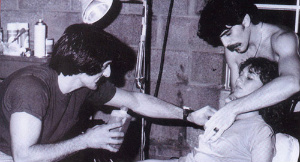
Cunningham calculated that he would need $500,000 to make the feature but the investors were only willing to offer $125,000. Unsure of how to proceed, he received a call from Scuderi who informed him that they were now willing to finance the entire budget but in return they wanted full control over the film. Cunningham refused and it seemed that the project was dead in the water until the following morning when he called Scuderi back to accept. By August 1979, Cunningham had a workable script and set out to scout for locations and a crew, whilst casting was handled by New York-based Barry Moss and Julie Hughes. After searching for a suitable summer camp in which they would be allowed to shoot a gory horror, Cunningham and Miner eventually settled on Camp No-Be-Bo-Sco, a New Jersey resort located between the Delaware Water Gap National Recreation Area and the Kittatinny Ridge in the region of New Jersey, Pennsylvania and New York. The script focused on a group of teenage counselors who head up to Camp Crystal Lake in order to help prepare it for its grand re-opening, having been closed for over twenty years after a series of bizarre events. But, one-by-one, they are slaughtered until only one, the smart and resourceful Alice, remains. In a surprise twist, the killer is revealed to be Mrs. Voorhees, a middle-aged former employee of the camp whose young son, Jason, had drowned due to staff negligence back in 1957.
The cast was primarily made up of relatively inexperienced young actors. Twenty-one year old Kevin Bacon had studied at the Circle in the Square Theatre School in New York before landing his first film role in National Lampoon’s Animal House before finding himself waiting tables. Having moved in the same acting circles as fellow wannabe stars Mark Nelson and Jeannine Taylor, the three had auditioned for Friday the 13th and had won the roles of Jack, Ned and Marcie, respectively. For the role of Mrs. Voorhees, however, Cunningham knew that he needed a recognizable name – much like Halloween had done with Donald Pleasence – and so approached Estelle Parsons who had appeared in the 1968 classic Bonnie & Clyde. Having been rejected on the grounds of the script being too violent, the producer then contacted the agent of Betsy Palmer, a faded star of the 1950’s who had since been reduced to forgettable television roles. Despite hating the script, she needed to pay for repairs on her car and so agreed to ten days work for $10,000. Knowing that he lacked the visual style of Carpenter, Cunningham needed a hook that would get audiences talking and, after viewing George A. Romero’s zombie epic Dawn of the Dead, decided upon its makeup artist. Tom Savini was a Vietnam vet and had made an impression with his groundbreaking special effects work on several low budget horrors throughout the ’70’s and, along with his close friend and assistant, Taso Stavrakis, agreed to work on the movie.
Filming on Friday the 13th took place between 4 September and 3 October 1979 in Blairstown, New Jersey and was a relatively enjoyable experience for all involved. The beautiful location allowed for Cunningham, who had taken the role of director as well as producer, to give an immediate sense of danger, with his protagonists lost in the wilderness. Savini’s work proved to be the magic ingredient that Cunningham had hoped, producing one breathtaking set piece after another, with perhaps the most astonishing being reserved for Bacon’s demise. Commonly referred to as the ‘arrow-through-the-throat’ gag, which had been storyboarded by Miner in explicit detail, and was achieved by Bacon’s body being hidden under the bed and a dummy lying out in front of him. A neck cast was applied to give the impression that Jack was lying on the bed and then a spear was driven through his neck from underneath. Unfortunately, the tubing was blocked, forcing Stavrakis to blow down the other end, resulting in the blood spraying out like an artery. Savini’s other high point was the decapitation during the action-packed climax which saw Mrs. Voorhees being beheaded by Alice (Adrienne King) with a machete. This was a relatively simple effect, in which Stavrakis (who had doubled as the killer for the majority of the movie as his face is never seen) poses as the antagonist (with his head out of view) and a mold of Palmer’s head attached on top with tooth picks. When the machete is swung – by Savini, no less – the picks were snapped and the head was severed from its body.
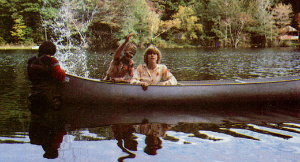
Knowing that the film needed a proper ending, and that the success of Brian De Palma’s 1976 hit Carrie had relied on its ‘jump’ at the end, it was decided that the final scene would see Alice adrift peacefully on the lake the following morning as a soothing piano tune from was played by composer Harry Manfredini (whose work would also be a major factor in the movie’s success). Suddenly, the deformed body of Jason jumped out of the water and dragged her down below, only for her to awake in a hospital bed to discover that her drowning was only a dream. The producers had no idea that this brief appearance of Jason would become a catalyst for thirty years of cinematic bloodshed, as Jason Voorhees would go on to become one of the most recognizable faces in horror history. There has been much dispute as to who actually conceived the ending, as everyone from Savini, Cunningham, Miller and Miner all claimed at one point to have been the instigator, but there is certainly no denying the effect that it had on audiences. With the film now complete, Cunningham set out to find a distributor, eventually settling on Paramount Pictures (with Warner Bros. securing the international rights).
Friday the 13th was finally released on May 9 1980 and would go on to earn almost $40m, largely due to an excessive marketing campaign that Paramount had Frank Mancuso, Sr. had produced. Its success would be responsible for the glut of slasher films that would be released during the early ’80’s – many of whom featured a deranged killer slaughtering a group of teens on a significant date – and so followed such efforts as Prom Night, My Bloody Valentine, Graduation Day, Happy Birthday to Me and April Fool’s Day. The MPAA (Motion Picture Association of America) had allowed the film through uncut, but when it became a hit they fell under pressure to enforce stricter regulations on censorship, resulting in many films that followed being severely edited prior to release. Many critics, most notably Roger Ebert and the late Gene Siskel on their weekly show Sneak Previews, expressed their distaste at the graphic nature of the movie and the slasher film, specifically Friday the 13th, fell foul of moral watchdogs and campaigners. Despite Paramount receiving major criticism for its involvement in such trash, once the box office figures began to roll in there was no question that there would be a sequel.
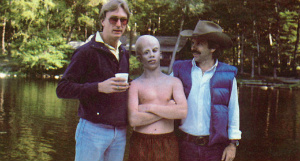

One Response to CRYSTAL LAKE’S BLOODY LEGACY pt.1 – Friday the 13th (1980)